Systematization of publications on the web. Part 2 of 3: Three Steps to Scientific Respectability
"The future is already here - it's just not very evenly distributed."
William Gibson
This series of articles includes 3 parts.
In the first part , a review of articles on the topic of scientific work published on habrahabr.ru was conducted, the concept of a citation index (h-index, Hirsch index) was examined, and the conclusion was drawn on the need for skills in working with scientometric databases for all who embarked on the path of a scientific career .
In this second part, we consider three tools for managing web publications: 1) Scopus; 2) Google Scholar (Google Academy); 3) Research Gate.
In the third partconsidered the choice of a strategy for scientific publications in order to promote a personal scientific brand. The examples in the article are considered for the scientific field that is familiar to the author - Computer Science.
Step 1: What is Scopus in my name?
If you have been writing articles in English for several years, then undoubtedly there is a trace of this activity on the Web. How to detect it? How to understand if you accidentally missed some important publication?
Of course, there are magazine sites and digital libraries, for example, in Computer Science, the IEEE Xplore , ACM, and Springler digital libraries are among the most authoritative and progressive .. If you have articles in journals or proceedings of conferences indexed in these digital libraries, then it will not be difficult to find them (for example, by the name of the author).
Scopus is able to collect and process data from many digital libraries. The main functionality of the system is paid, however, a simple search, including by author’s name, can be performed without an account.
We go to the Scopus website .
In the plain-looking window that opens, click on the link Author Preview .
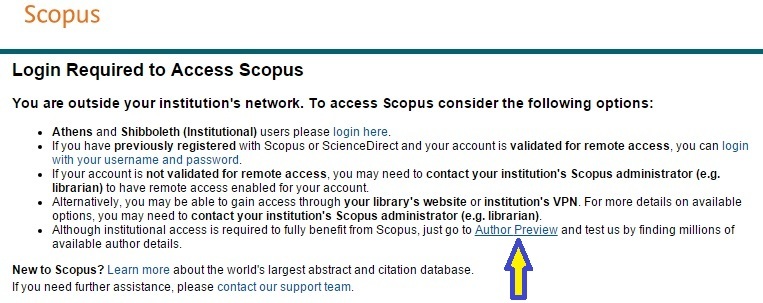
After that, we get to the search page. It is enough to enter the first and last name in the appropriate fields. To speed up the search below, using the flags, you can set the direction of your scientific activity (Subject Areas: Life Sciences, Health Sciences, Physical Sciences, Social Sciences and Humanities), for example, as it is done below (we are looking for my works).
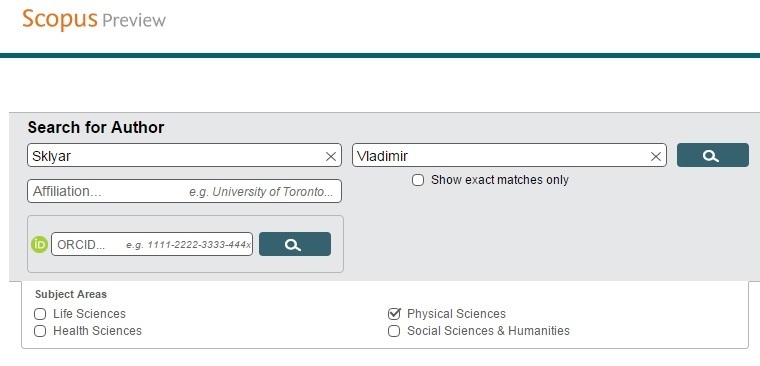
As it turned out, the search does an excellent job. The search engine defeats the difference in initials and in different transliteration of names. In addition, if suddenly in the database there were several options for spelling the name, then you can send a request, and the profiles will be aggregated.
After that, you can click on your name and see the individual card. As you can see, Scopuswith the attentiveness of the "big brother" follows our publications, career and citation. Of the points worth paying attention to, I would mention the Author ID (sometimes it is useful to know it) and the h-index (or Hirsch index), which was mentioned in the first part of the publication.

Many interface components are not available, this is a subject of a paid license. In civilized countries along the path of scientific and technological progress, universities and high-tech companies usually pay for corporate licenses for their employees.
Of the free tools, I found only the Author feedback wizard . By clicking on this link, you will get the opportunity in a few steps to get acquainted with the basic information regarding publications.
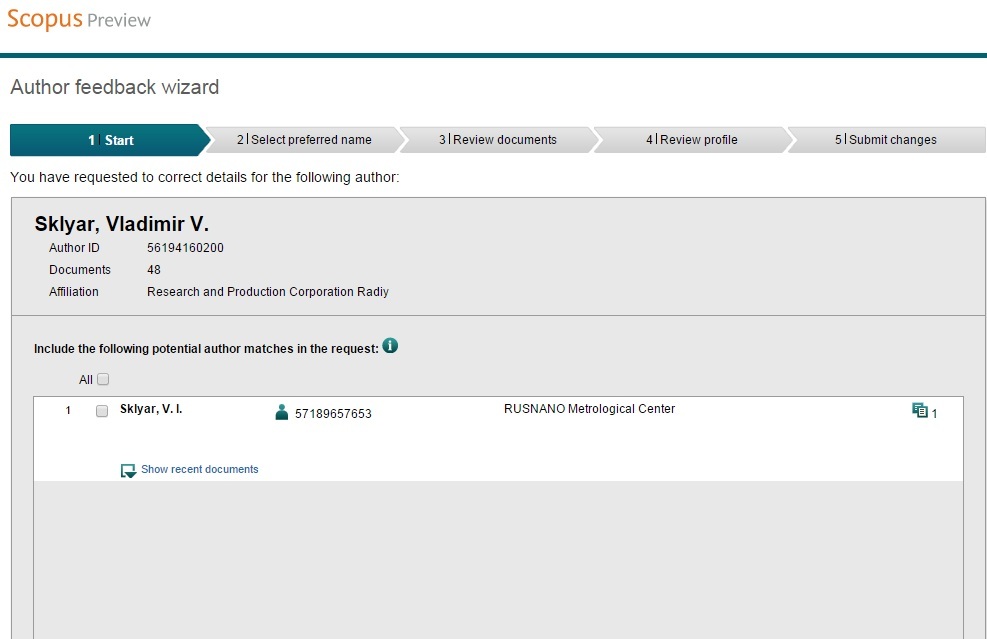
You can, for example, get a list of your publications in a fairly convenient form.

And then you can view the publication cards. It will not work to edit, this is the prerogative of Scopus .
Of course, this way you can view information not only about yours, but also about any publications you are interested in.
Thus, if you publish exclusively in highly rated magazines, then even there is no need to personally keep a record of your publications, Scopus will do everything for you.
Step 2: Google Scholar: looking forward to the future
Knowing Google’s skills in creating effective business models, you should pay attention to the Google Scholar service(Google Academy), integrated into Google services. It is obvious that at the moment this service is developing, although there are alternative opinions .
It is not difficult to create a Google Scholar profile on the basis of a common Google account, after which all your indexed works will be pulled there along with the cited sources and the results of calculating citation indexes.
There are six main options in the Google Scholar main menu (My Library, My Quotes, My Updates, Alerts, Metrics, Settings). Let's go over them.
In the "My Library" section you can find a complete list of both your own indexed works and those works to which you have links and which are also indexed.
If we click on the “Quote” link under any publication, we get a window in which the link is converted according to citation styles or in a typical file format (at the bottom of the window). If not all the information needed for citation was correctly pulled into the database, then it needs to be modified manually. Correction in the library itself is also possible. The set of citation patterns is quite limited. It is interesting that GOST got there, but, for example, the IEEE template is not provided, that is, it is necessary to finish it manually.
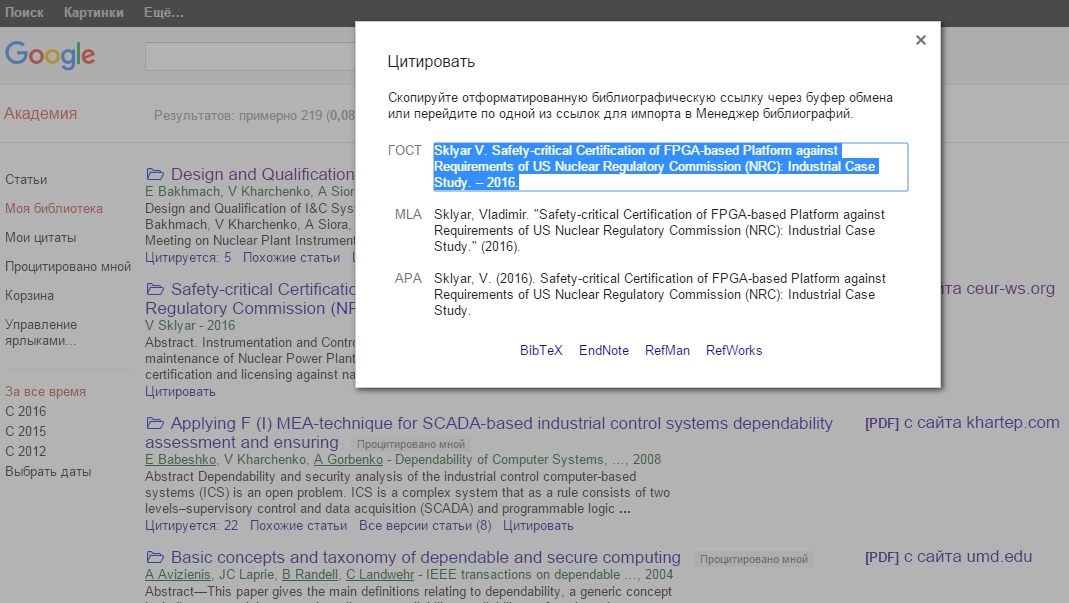
But in the section “My quotes” you can see a list of your own indexed publications and citation statistics.
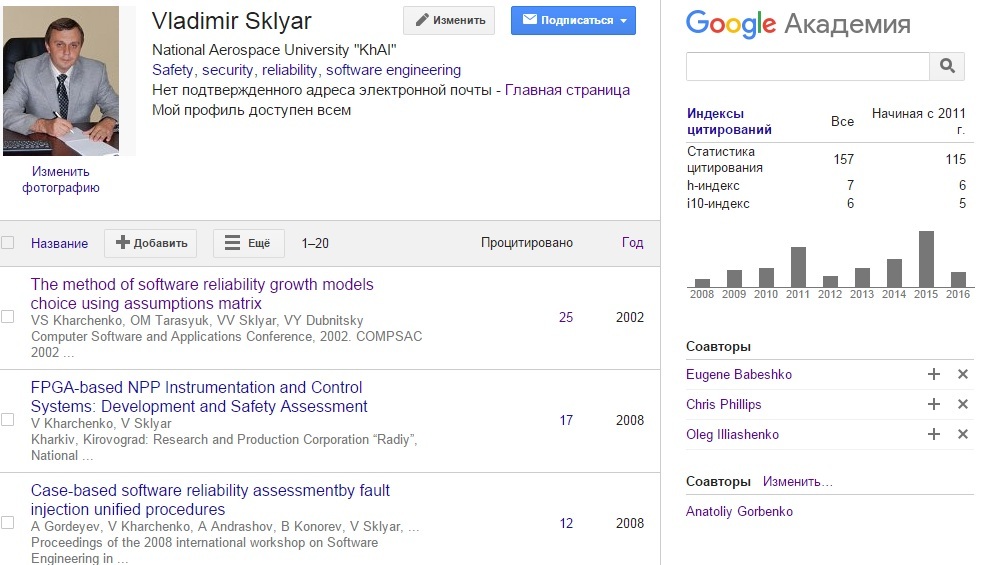
Publications can be added manually as a record, however, in my opinion, there isn’t much point in this. Fact that google scholaryou cannot “force” to index the added article, and it will be visible only to visitors to your profile. In addition, it will not be possible to add a link to a web resource with an article, even if one exists. That is, you will receive a private quote in the profile, no more, it will not be added to the general database.
In the "My Updates" section, Google Scholar collects links to publications that may be of interest to you based on what is already collected in your personal library. It seemed to me that excellent relevance is achieved here.
"Alerts" allow you to follow the publications of specific authors (supplemented by ikashnitsky commentary ).
If you go to the "Indicators", then we will see a list of indexed magazines. Magazines are carefully categorized and ranked by citation index. This is important for the analysis and selection of journals for subsequent publications. In the lower left corner of the window we see that not only English-language magazines are indexed, but also Russian-language ones (supplemented bycomment by @ikashnitsky).
The “settings” of the account (as well as the existing Help) are quite simple.
The noticed oddities of Google Scholar work are connected with imperfect indexing algorithms. For example, a collection of articles from a conference was recently released and indexed. It published two of my articles, however, Google Scholar for some reason chose only one of them. Scopus “saw” both articles.
In principle, the incorporated functionality seems to be quite adequate. I did not find how to create a list of work. In my opinion, this option is quite important, and it can be implemented quite simply.
Step 3: Research Gate: Scaling Your Personal Repository
After getting acquainted with the first two tools, the question arises: is it possible to add publications that are not indexed by leading scientometric databases? To do this, there are scientific social networks, of which I liked the most of Research Gate .
A good Research Gate is that it has its own search engine, which allows you to create your own scientometric base. Thus, your profile is automatically generated, even if you do not know about it.
In addition, Research GateIt has the typical functionality of a social network in terms of posting a profile, a variety of search options, messaging, etc. There are functions for posting and searching for vacancies with the corresponding specifics, i.e. university positions. There are functions for posting professional questions of network participants and answers to them.
However, let the development team itself say about the functionality. On the Research Gate website, you will find such a short description. Actually, this is the whole Help, everything else is only intuitive.

You have the opportunity to publish scientific results in the form of articles, sections of books, reports, etc. Alternatively, it is in Research Gateit makes sense to keep full of their publications, as well as other works and projects. The option of creating and maintaining projects is useful if there is a need to collect a collection of materials in a single section.
In addition, the site will measure in sufficient detail your social achievements, such as the number of readings and profile views, based on this, a personal rating will be determined according to the version of Research Gate , and an h-index will be calculated .
The list of publications (for example, in the form of a table) I could not form.
Another drawback is that once entered information on the publication to correct is no longer possible. If necessary, the easiest solution is to remove the publication and re-submit.
Web of Science: Paid but Cool
In this article, Web of Science (WoS) is not considered a working tool because its use is paid. However, it would be wrong to completely ignore Web of Science , since, along with Scopus , WoS is positioned as a leading scientometric base. I personally currently do not have access to Web of Science , I asked my friends “with access” to perform a search. This platform is the property of the global media group Thomson Reuters . It seems that these people form the face of modern scientometrics. The principles of operation are similar to the principles of work with Scopus . My publications inWeb of Science has turned out less than in Scopus , although, strictly speaking, this is a matter of promotion strategy.
Main conclusions
The appearance of our own scientific publications and their citation in scientometric databases should be monitored, and there are many reasons for this.
A simplified search in Scopus is currently available for free, but Web of Science recognizes only paid accounts.
Google Scholar is still not as widely recognized, but promising scientometric base. Given the simplicity of work, openness, rapid development and some likelihood of connecting the Russian-language segment in the near future, Google Scholarclearly recommended for use. In addition, Google Scholar implements the conversion to various formats of links to cited sources. On the other hand, the issues of managing scientific content are not fully addressed in this service.
Nevertheless, you may need a scientific social network with the functions of storing personal content in it, regardless of its inclusion in scientometric databases. Research Gate is quite suitable for such a role . The advantage of Research Gate is its own search engine, and the disadvantage is the very modest functionality of the bibliographic manager. There are other scientific social networks (the experience of their use by other authors is described on the "Habr", links to publications are in the first partof this article), their application is a matter of personal taste.
Perhaps the venerable public has some ideas on the above topic, therefore, I would like to continue the discussion in dialogue mode.
In addition, after reviewing the databases, I didn’t completely answer the question for myself: which database is “cooler”, the one where the least publications are indexed (high selectivity) or the one where the most publications are indexed (more material and cross-quotes )?
William Gibson
This series of articles includes 3 parts.
In the first part , a review of articles on the topic of scientific work published on habrahabr.ru was conducted, the concept of a citation index (h-index, Hirsch index) was examined, and the conclusion was drawn on the need for skills in working with scientometric databases for all who embarked on the path of a scientific career .
In this second part, we consider three tools for managing web publications: 1) Scopus; 2) Google Scholar (Google Academy); 3) Research Gate.
In the third partconsidered the choice of a strategy for scientific publications in order to promote a personal scientific brand. The examples in the article are considered for the scientific field that is familiar to the author - Computer Science.
Step 1: What is Scopus in my name?
If you have been writing articles in English for several years, then undoubtedly there is a trace of this activity on the Web. How to detect it? How to understand if you accidentally missed some important publication?
Of course, there are magazine sites and digital libraries, for example, in Computer Science, the IEEE Xplore , ACM, and Springler digital libraries are among the most authoritative and progressive .. If you have articles in journals or proceedings of conferences indexed in these digital libraries, then it will not be difficult to find them (for example, by the name of the author).
Scopus is able to collect and process data from many digital libraries. The main functionality of the system is paid, however, a simple search, including by author’s name, can be performed without an account.
We go to the Scopus website .
In the plain-looking window that opens, click on the link Author Preview .

After that, we get to the search page. It is enough to enter the first and last name in the appropriate fields. To speed up the search below, using the flags, you can set the direction of your scientific activity (Subject Areas: Life Sciences, Health Sciences, Physical Sciences, Social Sciences and Humanities), for example, as it is done below (we are looking for my works).

As it turned out, the search does an excellent job. The search engine defeats the difference in initials and in different transliteration of names. In addition, if suddenly in the database there were several options for spelling the name, then you can send a request, and the profiles will be aggregated.
After that, you can click on your name and see the individual card. As you can see, Scopuswith the attentiveness of the "big brother" follows our publications, career and citation. Of the points worth paying attention to, I would mention the Author ID (sometimes it is useful to know it) and the h-index (or Hirsch index), which was mentioned in the first part of the publication.

Many interface components are not available, this is a subject of a paid license. In civilized countries along the path of scientific and technological progress, universities and high-tech companies usually pay for corporate licenses for their employees.
Of the free tools, I found only the Author feedback wizard . By clicking on this link, you will get the opportunity in a few steps to get acquainted with the basic information regarding publications.

You can, for example, get a list of your publications in a fairly convenient form.

And then you can view the publication cards. It will not work to edit, this is the prerogative of Scopus .
Of course, this way you can view information not only about yours, but also about any publications you are interested in.
Thus, if you publish exclusively in highly rated magazines, then even there is no need to personally keep a record of your publications, Scopus will do everything for you.
Step 2: Google Scholar: looking forward to the future
Knowing Google’s skills in creating effective business models, you should pay attention to the Google Scholar service(Google Academy), integrated into Google services. It is obvious that at the moment this service is developing, although there are alternative opinions .
It is not difficult to create a Google Scholar profile on the basis of a common Google account, after which all your indexed works will be pulled there along with the cited sources and the results of calculating citation indexes.
There are six main options in the Google Scholar main menu (My Library, My Quotes, My Updates, Alerts, Metrics, Settings). Let's go over them.
In the "My Library" section you can find a complete list of both your own indexed works and those works to which you have links and which are also indexed.
If we click on the “Quote” link under any publication, we get a window in which the link is converted according to citation styles or in a typical file format (at the bottom of the window). If not all the information needed for citation was correctly pulled into the database, then it needs to be modified manually. Correction in the library itself is also possible. The set of citation patterns is quite limited. It is interesting that GOST got there, but, for example, the IEEE template is not provided, that is, it is necessary to finish it manually.

But in the section “My quotes” you can see a list of your own indexed publications and citation statistics.

Publications can be added manually as a record, however, in my opinion, there isn’t much point in this. Fact that google scholaryou cannot “force” to index the added article, and it will be visible only to visitors to your profile. In addition, it will not be possible to add a link to a web resource with an article, even if one exists. That is, you will receive a private quote in the profile, no more, it will not be added to the general database.
In the "My Updates" section, Google Scholar collects links to publications that may be of interest to you based on what is already collected in your personal library. It seemed to me that excellent relevance is achieved here.
"Alerts" allow you to follow the publications of specific authors (supplemented by ikashnitsky commentary ).
If you go to the "Indicators", then we will see a list of indexed magazines. Magazines are carefully categorized and ranked by citation index. This is important for the analysis and selection of journals for subsequent publications. In the lower left corner of the window we see that not only English-language magazines are indexed, but also Russian-language ones (supplemented bycomment by @ikashnitsky).
The “settings” of the account (as well as the existing Help) are quite simple.
The noticed oddities of Google Scholar work are connected with imperfect indexing algorithms. For example, a collection of articles from a conference was recently released and indexed. It published two of my articles, however, Google Scholar for some reason chose only one of them. Scopus “saw” both articles.
In principle, the incorporated functionality seems to be quite adequate. I did not find how to create a list of work. In my opinion, this option is quite important, and it can be implemented quite simply.
Step 3: Research Gate: Scaling Your Personal Repository
After getting acquainted with the first two tools, the question arises: is it possible to add publications that are not indexed by leading scientometric databases? To do this, there are scientific social networks, of which I liked the most of Research Gate .
A good Research Gate is that it has its own search engine, which allows you to create your own scientometric base. Thus, your profile is automatically generated, even if you do not know about it.
In addition, Research GateIt has the typical functionality of a social network in terms of posting a profile, a variety of search options, messaging, etc. There are functions for posting and searching for vacancies with the corresponding specifics, i.e. university positions. There are functions for posting professional questions of network participants and answers to them.
However, let the development team itself say about the functionality. On the Research Gate website, you will find such a short description. Actually, this is the whole Help, everything else is only intuitive.

You have the opportunity to publish scientific results in the form of articles, sections of books, reports, etc. Alternatively, it is in Research Gateit makes sense to keep full of their publications, as well as other works and projects. The option of creating and maintaining projects is useful if there is a need to collect a collection of materials in a single section.
In addition, the site will measure in sufficient detail your social achievements, such as the number of readings and profile views, based on this, a personal rating will be determined according to the version of Research Gate , and an h-index will be calculated .
The list of publications (for example, in the form of a table) I could not form.
Another drawback is that once entered information on the publication to correct is no longer possible. If necessary, the easiest solution is to remove the publication and re-submit.
Web of Science: Paid but Cool
In this article, Web of Science (WoS) is not considered a working tool because its use is paid. However, it would be wrong to completely ignore Web of Science , since, along with Scopus , WoS is positioned as a leading scientometric base. I personally currently do not have access to Web of Science , I asked my friends “with access” to perform a search. This platform is the property of the global media group Thomson Reuters . It seems that these people form the face of modern scientometrics. The principles of operation are similar to the principles of work with Scopus . My publications inWeb of Science has turned out less than in Scopus , although, strictly speaking, this is a matter of promotion strategy.
Main conclusions
The appearance of our own scientific publications and their citation in scientometric databases should be monitored, and there are many reasons for this.
A simplified search in Scopus is currently available for free, but Web of Science recognizes only paid accounts.
Google Scholar is still not as widely recognized, but promising scientometric base. Given the simplicity of work, openness, rapid development and some likelihood of connecting the Russian-language segment in the near future, Google Scholarclearly recommended for use. In addition, Google Scholar implements the conversion to various formats of links to cited sources. On the other hand, the issues of managing scientific content are not fully addressed in this service.
Nevertheless, you may need a scientific social network with the functions of storing personal content in it, regardless of its inclusion in scientometric databases. Research Gate is quite suitable for such a role . The advantage of Research Gate is its own search engine, and the disadvantage is the very modest functionality of the bibliographic manager. There are other scientific social networks (the experience of their use by other authors is described on the "Habr", links to publications are in the first partof this article), their application is a matter of personal taste.
Perhaps the venerable public has some ideas on the above topic, therefore, I would like to continue the discussion in dialogue mode.
In addition, after reviewing the databases, I didn’t completely answer the question for myself: which database is “cooler”, the one where the least publications are indexed (high selectivity) or the one where the most publications are indexed (more material and cross-quotes )?
